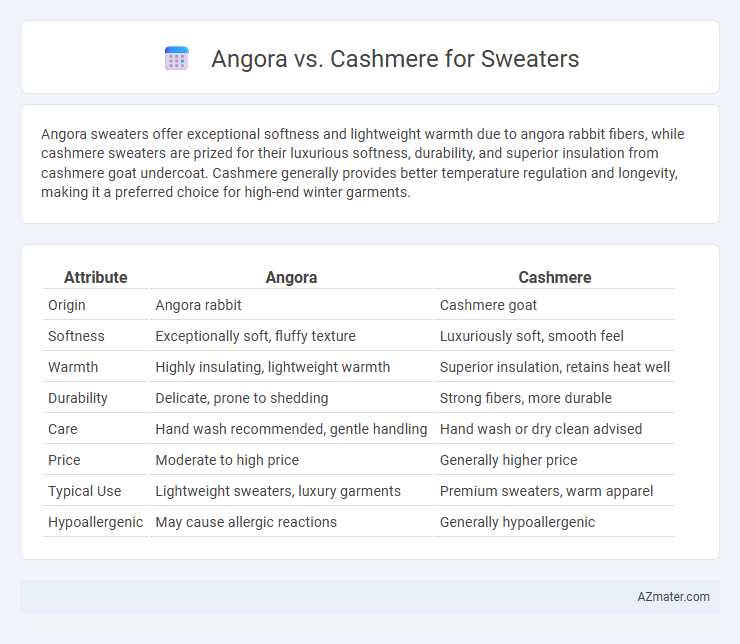Angora sweaters offer exceptional softness and lightweight warmth due to angora rabbit fibers, while cashmere sweaters are prized for their luxurious softness, durability, and superior insulation from cashmere goat undercoat. Cashmere generally provides better temperature regulation and longevity, making it a preferred choice for high-end winter garments.
Table of Comparison
| Attribute | Angora | Cashmere |
|---|---|---|
| Origin | Angora rabbit | Cashmere goat |
| Softness | Exceptionally soft, fluffy texture | Luxuriously soft, smooth feel |
| Warmth | Highly insulating, lightweight warmth | Superior insulation, retains heat well |
| Durability | Delicate, prone to shedding | Strong fibers, more durable |
| Care | Hand wash recommended, gentle handling | Hand wash or dry clean advised |
| Price | Moderate to high price | Generally higher price |
| Typical Use | Lightweight sweaters, luxury garments | Premium sweaters, warm apparel |
| Hypoallergenic | May cause allergic reactions | Generally hypoallergenic |
Understanding Angora and Cashmere Fibers
Angora fibers, sourced from Angora rabbits, are exceptionally soft and lightweight with excellent warmth retention and a distinctive fluffy texture. Cashmere, derived from the undercoat of Cashmere goats, offers a fine, silky feel that is highly insulating and known for its durability and smooth touch. Both fibers provide premium softness but differ in their origin, texture, and natural insulating properties, influencing sweater performance and comfort.
Origin and Production Process
Angora wool originates from the Angora rabbit, primarily farmed in regions like Turkey, France, and Chile, where fibers are harvested via gentle combing to ensure animal welfare. Cashmere comes from the undercoat of cashmere goats mainly found in Mongolia, China, and Iran, with fibers collected through careful combing or shearing during the molting season. The production process of Angora emphasizes softness and fluffiness, while Cashmere focuses on fine, insulating fibers, resulting in distinct textures and warmth levels in sweaters.
Texture and Softness Comparison
Angora fibers provide a lightweight, fluffy texture with exceptional softness due to their hollow core, creating natural insulation and a silky feel that enhances sweater comfort. Cashmere, sourced from the undercoat of Cashmere goats, delivers a denser, smoother texture with fine, soft fibers that offer warmth without bulk, prized for its luxurious softness. Both fibers excel in softness, but Angora's fluffiness contrasts with Cashmere's sleek smoothness, influencing sweater texture and overall wearability.
Warmth and Insulation Qualities
Angora fibers, sourced from Angora rabbits, are renowned for their exceptional softness and superior warmth due to hollow fiber structure that traps air, providing excellent insulation in sweaters. Cashmere, derived from Cashmere goats, offers remarkable warmth with fine, dense fibers that retain heat effectively while maintaining lightweight breathability. Both materials excel in insulation, but Angora generally delivers a warmer, fluffier feel ideal for cold climates, whereas Cashmere balances warmth with durability and moisture-wicking properties.
Durability and Longevity
Angora fibers, derived from Angora rabbits, provide exceptional softness but tend to pill and wear faster compared to cashmere, making them less durable for everyday sweaters. Cashmere, sourced from the undercoat of Cashmere goats, boasts superior strength and resilience, allowing sweaters to maintain shape and texture over extended periods with proper care. Investing in cashmere sweaters often results in longer-lasting garments, while angora pieces require delicate maintenance to extend their lifespan.
Ethical and Environmental Impact
Angora wool production raises ethical concerns due to animal welfare issues, as Angora rabbits often endure stressful conditions and painful plucking processes. Cashmere, sourced from Cashmere goats, presents environmental challenges including overgrazing, which leads to land degradation and desertification. Sustainable alternatives in both fibers emphasize cruelty-free practices and responsible grazing management to minimize ecological footprints in sweater manufacturing.
Maintenance and Care Requirements
Angora sweaters require gentle hand washing or dry cleaning to preserve the delicate, fluffy fibers and prevent matting or shedding. Cashmere sweaters, while also delicate, benefit from cold water hand washing with mild detergent and careful drying flat to maintain softness and prevent stretching. Both fibers demand proper storage in breathable bags with moth repellents to avoid damage and extend garment longevity.
Price Differences Explained
Angora sweaters typically carry a higher price tag due to the labor-intensive process of harvesting mohair fibers from Angora rabbits, which yields limited quantities per animal compared to cashmere goats. Cashmere tends to be more affordable but varies widely depending on the grade and origin, with premium cashmere sourced from Inner Mongolia commanding prices closer to Angora. Price differences also reflect durability and softness; Angora offers exceptional warmth and a silky texture, justifying its premium cost for luxury knitwear.
Style and Versatility in Sweaters
Angora sweaters offer a soft, fluffy texture with a luxurious sheen that adds a sophisticated, cozy look to any outfit, making them ideal for statement pieces in the fall and winter. Cashmere sweaters provide a smooth, lightweight feel with excellent insulation, allowing for versatile styling--from casual layering to elegant office wear. Both fibers enhance sweater versatility, but cashmere's finer gauge supports a wider range of silhouettes and temperature adaptability.
Choosing the Best Option for Your Needs
Angora offers luxurious softness and exceptional warmth due to its fine rabbit fibers, ideal for those seeking lightweight yet insulating sweaters. Cashmere provides unparalleled smoothness and durability from goat undercoat fibers, making it perfect for long-lasting, high-quality garments. Selecting between Angora and Cashmere depends on your preference for warmth, texture, and durability in a sweater tailored to your lifestyle.

Infographic: Angora vs Cashmere for Sweater
 azmater.com
azmater.com